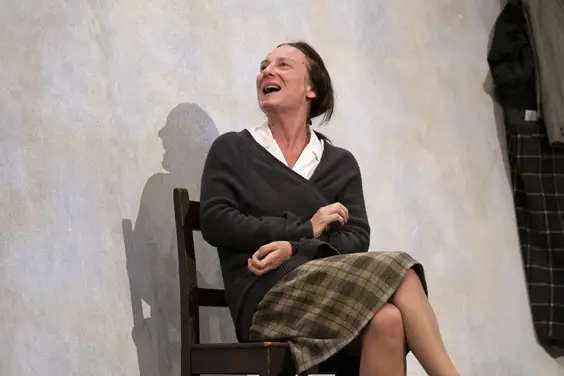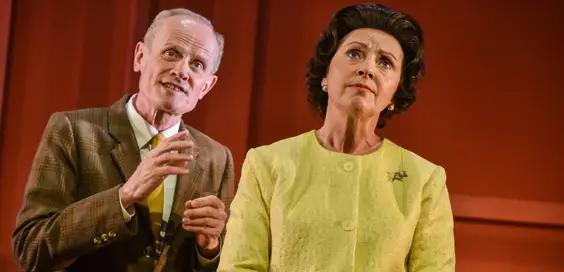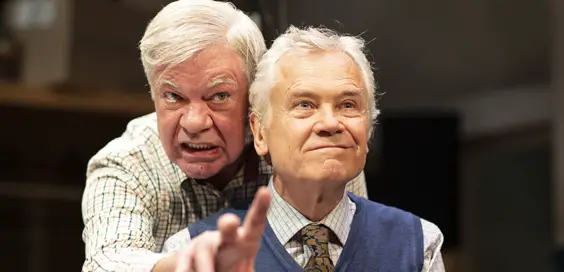Talking Heads: Susan, Doris & Irene – Review – West Yorkshire Playhouse
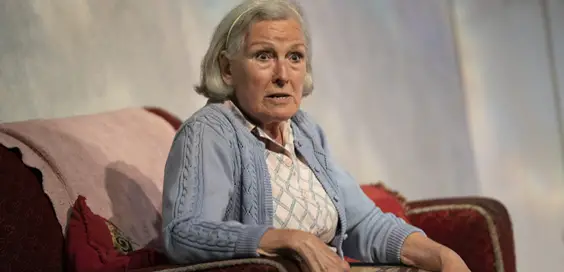
By Eve Luddington, June 2018
Imagine the thrill of watching live theatre in your own sitting room. Well, last week people across Leeds did just that. West Yorkshire Playhouse toured Alan Bennett’s celebrated Talking Heads to 28 of the city’s 29 postcodes, from a flat in Seacroft to a living room in Boston Spa, from Headingly Stadium to Leeds City College. It’s a brilliant idea, perfectly suited to these monologues which were all written for TV and mostly set around Leeds by our most famous Leeds-born playwright. On TV each Talking Head feels like a one-to-one, very intimate encounter. When I watched them first in the 1980s, I wanted to interrupt to advise, to challenge, to help. I imagine those lucky enough to see them at home felt similarly.
But the last postcode venue of this city tour is in LS2, the Courtyard Theatre at West Yorkshire Playhouse. It’s the last production to be staged there before redevelopment, and that’s where I saw three of the Talking Heads this week.
Alan Bennett is often called a ‘National Treasure’. His absent-minded, slightly shambling appearance and gentle voice fit the usual definition of that phrase – but appearances are often deceptive. I suspect it’s not only his diffidence that makes Bennett reject the term and its cuddly connotations. It severely diminishes his work. Neither he nor his characters are cuddly. Talking Heads, like much of Bennett’s work, is ironically funny and very sharp. It shines a bright light on ‘normal’ lives like our own and, in the most engaging manner, illuminates the dark aspects of ourselves that we normally avoid.
“Enormous wit and irony”
Bennett’s sublime writing translates effortlessly to the stage. A self-confessed eavesdropper, he uses everyday patterns of language, complete with repetition and half-finished sentences, to create poetic, compelling monologues for his characters. All are ‘ordinary people’ in difficult situations which they have partially created for themselves. But, as Alan Bennett wrote in his introduction to Talking Heads (BBC Books, 2007 edition): ‘These narrators are artless. They don’t quite know what they are saying and are telling a story to the meaning of which they are not entirely privy.’
There is enormous wit and irony in the writing. The actors have to communicate it in a way which gives the audience more insight into the narrators and their situations than the characters might themselves possess. Bennett’s writing and its rhythms ‘leave… the actor a very useful road-map’, but it’s still a challenge for any actor to be alone on stage with an audience and such a finely tuned script for 30 or 40 minutes.
The three pieces I saw are all for middle-aged or elderly women. Each actor found the rhythm and tone of her character and created a close rapport with the audience. Doubts I had that the intimacy of a TV performance could not be transferred to the stage were unfounded.
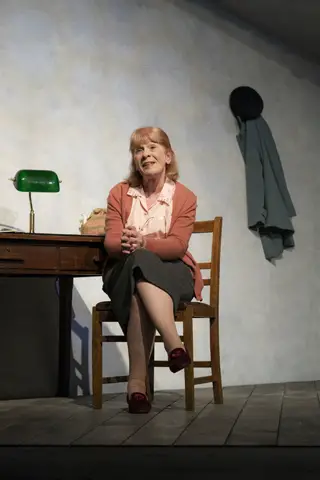 “Underlying isolation and loneliness”
“Underlying isolation and loneliness”
In ‘Bed Among the Lentils’, Cate Hamer plays Susan, the unhappy vicar’s wife who feels trapped by her husband, his adoring female acolytes and their expectations of her. She, herself, relies on alcohol rather than God or husband Geoffrey to revive her spirits. Hamer inhabits the part entirely. A lot of the time she’s in an outsize cardigan which she pulls close like a second skin, her worn expression and waspish comments epitomise Susan’s frustrations. At the discovery of Mr Ramesh and his shop opposite the LGI, she sparkles and is transformed. And when Susan sobers up, Hamer’s whole demeanour changes again. She carried the audience with her on Susan’s journey, playing the wit to its hilt and the pathos beautifully
As Irene, the compulsive complainant and self-appointed community vigilante in ‘A Lady of Letters’, Vanessa Rosenthal has the misplaced righteous indignation of the character to a tee whether telling us about discovering a hair in a packet of sausages or informing the authorities about perceived child abuse. Irene’s restless need to address any ‘wrong’, from the ridiculously funny to the offensive and illegal, veils her underlying isolation and loneliness. These come through too in Rosenthal’s performance, which raised many laughs and some sharp intakes of breath – though I did find the continual shifting of her chair over-fussy.
‘A Cream Cracker Under the Settee’ is, perhaps, the most daunting of these monologues because, for many who are familiar with the piece, it’s almost synonymous with Thora Hird’s original TV performance. Marlene Sidaway, as Doris, made the part her own from the start. Doris, widowed and living alone, is a proud woman whose overwhelming fear is that she will be sent to Stafford House, a care home. In striving to maintain her scrupulous standards of cleanliness, she has climbed on a stool to dust a photo of husband, Wilfred, and herself, and has fallen. As her predicament dawns on her she reminisces and we gain insight into the sorrows of her life, her tetchiness and discontent with Wilfred.
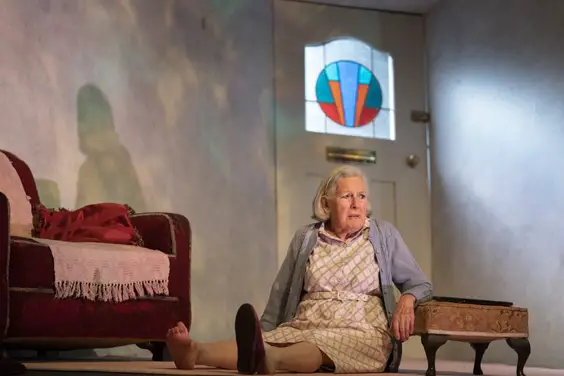 “Sense of confinement”
“Sense of confinement”
This piece has less comedy and greater poignancy than the other two monologues. Doris needs but refuses help. Sidaway’s wonderful performance created an intimacy which I found very moving. I was so carried away that I felt uncomfortable sitting and watching. The image of her shuffling on her bottom between settee and front door will stay with me for a long time.
James Brining, Amy Leach and John R. Wilkinson, the directors, enabled three exceptional performances but they had technical challenges in making Talking Heads work on the Courtyard stage. For me, some of the technical choices didn’t serve the production.
The first two monologues require very little in the way of set, I think, but ‘Cream Cracker’ really needs a room with a settee and a door. Therefore, in a theatre venue, some set is demanded. The basic, all-purpose one chosen was a cleverly designed room by Laura Ann Price, a door’s width upstage and opening out to the audience. It conveyed excellently each character’s sense of confinement. But were the set changes during the monologues necessary? I don’t think so. They delayed the action, interrupted the rhythm of the pieces and, to my mind, added nothing. They were accompanied by repetitive electronic music which also played before the performance, during dramatic pauses, between monologues and in the interval. It was a dreary noise which, for me, had no relevance to Talking Heads and annoyed me to distraction. And, while I’m in complaining mood, I’ll add that I still have no idea why the image greeting the audience before the show, while the noise droned away, was a holiday company advert.
These elements, for me, detracted from an otherwise excellent production. I left the theatre delighted by three powerful performances. Judging by the enthusiastic response, so did the rest of the audience.
images: Richard H. Smith
